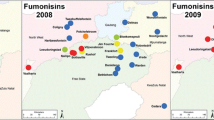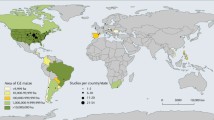Abstract
Fumonisins are common contaminants of maize (Zea mays L.) grain products, especially in countries where maize is a major constituent of the diet and are harmful to human and animal health. There is a need to better define environmental conditions that favor fumonisin accumulation in the grain of maize. The impacts of biotic and abiotic factors, and hybrids containing the Cry1Ab protein from Bacillus thuringiensis (Bt), were associated with fumonisin accumulation in the grain of maize across contrasting environments in Argentina and the Philippines between 2000 and 2002. Average fumonisin concentrations in grain samples varied from 0.5 to 12 μg g−1 across field locations in Argentina, and from 0.3 to 1.8 μg g−1 across locations in the Philippines. The ratio of fumonisin B1 to fumonisin B2 was <3.0 in four of nine locations in Argentina, which proved to be due to a higher prevalence of Fusarium proliferatum in those locations. Most of the variability of total fumonisins among maize grain samples was explained by location or weather (47%), followed by insect damage severity in mature ears (17%), hybrid (14%), and with the use of Bt hybrids (11%). In Argentina, where conditions were more favorable for accumulation of fumonisin in the years considered, fumonisin concentrations were lower in Bt hybrids compared to their genetic isolines by an average of 40%. A model was developed to predict fumonisin concentration using insect damage to ears and weather variables as predictors in the model. Four periods of weather around silking were identified as critical for fumonisin concentrations at harvest. The model accounted for 82% of the variability of total fumonisin across all locations in 2 years of the study.
Similar content being viewed by others
References
WFO Marasas JD Miller RT Riley A Visconti (2001) Fumonisins – Occurrence, toxicology, metabolism and risk assessment BA Summerell JF Leslie D Backhouse WL Bryden LW Burgess (Eds) Fusarium Paul E. Nelson Symposium APS Press St. Paul 332–359
JD Miller (1994) Epidemiology of Fusarium ear diseases JD Miller HL Trenholm (Eds) Mycotoxins in Grain: Compounds Other than Aflatoxin. Eagan Press St. Paul 19–36
JJ Pestka GS Bondy (1994) Immunotoxic effects of mycotoxins JD Miller HL Trenholm (Eds) Mycotoxins in Grain: Compounds other than Aflatoxin. The American Phytopathological Society St. Paul 339–358
JP Rheeder WFO Marasas PG Thiel EW Sydenham GS Shephard DJV Schalkwyck (1992) ArticleTitleFusarium moniliforme and fumonisins in corn in relation to esophageal cancer in Transkei Phytopathology 82 353–357
ME Stack (1998) ArticleTitleAnalysis of fumonisin B1 and its hydrolysis product in tortillas J AOAC Int 81 737–740 Occurrence Handle1:CAS:528:DyaK1cXkslWrsr4%3D Occurrence Handle9680698
CFSAN. Guidance for Industry: Fumonisin Levels in Human Foods and Animal Feeds. USFDA Center for Food Safety and Applied Nutrition and the Center for Veterinary Medicine. 2001. (http://www.cfsan.fda.gov/dms/fumongu2.html) (Accessed March 2004)
BL Bullerman (1996) Occurrence of Fusarium and fumonisins on food grains and in food LS Jackson JW Devries BL Bullerman (Eds) Fumonisins in Food Plenum Press New York and London 27–38
GP Munkvold DC McGee WM Carlton (1997) ArticleTitleImportant of different pathways for maize kernel infection by Fusarium moniliforme Phytopathology 87 209–217
N Ali Sardjono A Yamashita T Yoshizawa (1998) ArticleTitleNatural co-occurrence of aflatoxins and Fusarium mycotoxins (fumonisins, deoxynivalenol, nivalenol and zearalenone) in corn from Indonesia Food Addit Contam 15 377–384 Occurrence Handle1:CAS:528:DyaK1cXjt1Chtbg%3D Occurrence Handle9764205
MB Doko S Rapior A Visconti JE Schjoth (1995) ArticleTitleIncidence and levels of fumonisin contamination in maize genotypes grown in Europe and Africa J Agric Food Chem 43 429–434 Occurrence Handle10.1021/jf00050a032 Occurrence Handle1:CAS:528:DyaK2MXjsFSks7g%3D
A Yamashita T Yoshizawa Y Aiura PC Sanchez EI Dizon RH Arim Sardjono (1995) ArticleTitleFusarium mycotoxins (fumonisins, nivalenol, and zearalenone) and aflatoxins in corn from Southeast Asia Biosci Biotech Biochem 59 1804–1807 Occurrence Handle1:CAS:528:DyaK2MXosFShur0%3D
Yoshizawa T, Yamashita A. Natural co-occurrence of fumonisins and aflatoxins, carcinogenic mycotoxins in corn and corn products in the Philippines. Occurrence Microbiol Control Mycotoxins Foodstuffs & Other Agric Commod 1995; 25–36
GP Munkvold (2003) ArticleTitleEpidemiology of Fusarium disease and their mycotoxins in maize Eur J Plant Pathol 109 705–713 Occurrence Handle10.1023/A:1026078324268 Occurrence Handle1:CAS:528:DC%2BD3sXnslSgt7Y%3D
A Logrieco G Mule A Moretti A Bottalico (2002) ArticleTitleToxigenic Fusarium species and mycotoxins associated with maize ear rot in Europe Eur J Plant Pathol 108 597–609 Occurrence Handle10.1023/A:1020679029993 Occurrence Handle1:CAS:528:DC%2BD38XnvVyisL4%3D
CW Hesseltine RF Rogers OL Shotwell (1993) ArticleTitleAflatoxin and mold flora in North Carolina in 1977 corn crop Mycologia 73 216–228
Miller JD, Savard ME, Schaafsma AW, Seifert KA, Reid LM. Mycotoxin production by Fusarium moniliforme and Fusarium proliferatum from Ontario and occurrence of fumonisin in the 1993 corn crop. Can J Plant Pathol 17: 233–239
M Pascale A Visconti M Pronczuk H Wisniewska J Chelkowski (1997) ArticleTitleAccumulation of fumonisins in maize hybrids inoculated under field conditions with Fusarium moniliforme Sheldon J Sci Food Agric 74 1–6 Occurrence Handle10.1002/(SICI)1097-0010(199705)74:1<1::AID-JSFA752>3.3.CO;2-X Occurrence Handle1:CAS:528:DyaK2sXjvVWjt7k%3D
M Ramirez M Pascale S Chultze MM Reynoso G March A Visconti (1996) ArticleTitleNatural occurrence of fumonisins and their correlation to Fusarium contamination in commercial corn hybrids grown in Argentina Mycopathologia 135 29–34 Occurrence Handle10.1007/BF00436572 Occurrence Handle1:CAS:528:DyaK2sXhtFCku7c%3D
MC Shurtleff (1980) Compendium of Corn Disease American Phytopathological Society St. Paul, MN
JD Miller (2001) ArticleTitleFactors that affect the occurrence of fumonisin Environ Health Persp 109 IssueID2 321–324 Occurrence Handle1:CAS:528:DC%2BD3MXktVOgt7Y%3D
LM Reid RW Nicol T Ouellet M Savard JD Miller JC Young DW Stewart AW Schaafsma (1999) ArticleTitleInteraction of Fusarium graminearum and F. moniliforme in maize ears: Disease progress, fungal biomass, and mycotoxin accumulation Phytopathology 89 1028–1037 Occurrence Handle1:CAS:528:DyaK1MXnsVGqsb8%3D
RA Shelby DG White EM Bauske (1994) ArticleTitleDifferential fumonisin production in maize hybrids Plant Dis 78 IssueID6 582–584 Occurrence Handle1:CAS:528:DyaK2cXlslGhsb4%3D
MB Doko C Canet N Brown EW Sydenham S Mpuchane BA Siame (1996) ArticleTitleNatural co-occurrence of fumonisins and zearalenone in cereals and cereal-based foods from Eastern and Southern Africa J Agric Food Chem 44 3240–3243 Occurrence Handle10.1021/jf960257+ Occurrence Handle1:CAS:528:DyaK28XlvVeru7c%3D
A Visconti (2001) ArticleTitleFumonisins in maize genotypes grown in various geographic areas Adv Exp Med Bio 392 193–204
J Duvick (2001) ArticleTitleProspects for reducing fumonisin contamination of maize through genetic modification Environmental Health Perspectives 109 337–342 Occurrence Handle1:CAS:528:DC%2BD3MXktVOgtL8%3D Occurrence Handle11359705
B Bakan D Melcion D Richard-Molard B Cahagnier (2002) ArticleTitleFungal growth and Fusarium mycotoxin content in isogenic traditional maize and genetically modified maize grown in France and Spain J Agric Food Chem 50 728–731 Occurrence Handle10.1021/jf0108258 Occurrence Handle1:CAS:528:DC%2BD38XhvFOiug%3D%3D Occurrence Handle11829636
GP Munkvold RL Hellmich WB Showers (1997) ArticleTitleReduced Fusarium ear rot and symptomless infections of maize genetically engineered for European Corn Borer Resistance Phytopathology 87 1071–1077
GP Munkvold RL Hellmich LP Rice (1999) ArticleTitleComparison of fumonisin concentrations in kernels of transgenic Bt maize hybrids and nontransgenic hybrids Plant Dis 83 130–138
BG Hammond K Campbell C Pilcher T DeGooyer A Robinson B McMillen S Spangler S Riordan L Rice J Richard (2004) ArticleTitleLower fumonisin mycotoxin levels in the grain of Bt corn grown in the United States in 2000–2002 J Agric Food Chem 52 IssueID5 1390–1397 Occurrence Handle1:CAS:528:DC%2BD2cXpvFGksw%3D%3D Occurrence Handle14995151
Riley RT, Miller JD. Case study: Risk analysis of fumonisin. In: Food Safety – Risk Analysis, A Manual Published By The United Nations Food & Agriculture Organization, ILSI and The Industry Council For Development. United Nations Food and Agriculture Organization, The International Life Sciences Institute and the Industry Council for Development, Rome, Italy, 2003
DC Hooker AW Schaafsma L Tamburic-Ilincic (2002) ArticleTitleUsing weather variables pre- and post-heading to predict deoxynivalenol content in winter wheat Plant Dis 86 611–619
DC Hooker AW Schaafsma (2003) ArticleTitleThe Doncast model: using weather variables pre- and post-heading to predict deoxynivalenol content in winter wheat Aspects Appl Biol 68 117–122
Dowd PF, Bartelt RJ, Beck JJ, Barnett J, Berhow MA, Duvick JP, Lagrimini ML, Molid GA, White DG. Insect management for reduction of mycotoxins in midwest corn FY-2001 report. In: Proceedings of the 1st fungal genomics, 2nd fumonisin elimination and 14th aflatoxin elimination workshops. Phoenix, Arizona 2001; pp. 83–84
J Stave (2002) ArticleTitleProtein immunoassay methods for the detection of biotech crops: Applications, limitations, and practical considerations J AOAC Int 85 780–786 Occurrence Handle1:CAS:528:DC%2BD38XksFWltL8%3D Occurrence Handle12083275
A Visconti M Solfrizzo A De Girolamo (2001) ArticleTitleDetermination of fumonisins B1 and B2 in corn and corn flakes by liquid chromatography with immunoaffinity column clean-up: Collaborative study J AOAC Int 84 1828–1138 Occurrence Handle1:CAS:528:DC%2BD38XhtFGjtL0%3D Occurrence Handle11767152
SM Nash WC Snyder (1962) ArticleTitleQuantitative estimations by plate counts of propagules of the bean root rot Fusarium in field soils Phytopathology 52 567–572
HI Nirenberg (1976) ArticleTitleUntersuchungen uber die morphologische und biologische Differenzierung in der Fusarium- Sektion Liseola Mitt Biol Bundesanst Land Forstwirtsch Berlin-Dahlem 169 1–117
PA Nelson TA Toussoun WFO Marasas (1983) Fusarium Species: An Illustrated Manual for Identification Pennsylvania State University Press University Park, PA
InstitutionalAuthorNameSAS Institute (1985) SAT-STAT Guide. version X SAS Institute Cary, NC
ME Cawood WCA Gelderblom AR Vleggaar Y Behrend PG Thiel WFO Marasas (1991) ArticleTitleIsolation of the fumonisin mycotoxins: A quantitative approach J Agric Food Chem 39 1958–1962 Occurrence Handle10.1021/jf00011a014 Occurrence Handle1:CAS:528:DyaK3MXmsV2lurY%3D
EW Sydenham GS Shephard PG Thiel (1992) ArticleTitleLiquid chromatographic determination of fumonisins B1, B2, and B3 in foods and feeds J AOAC Int 75 313–318 Occurrence Handle1:CAS:528:DyaK38XkvVyqsro%3D
SN Chulze M Ramirez M Pascale A Visconti (1998) ArticleTitleFumonisin production by, and mating populations of, Fusarium section Liseola isolates from maize in Argentina Mycol Res 1202 141–144 Occurrence Handle10.1017/S0953756297004772
TK Cotten GP Munkvold (1998) ArticleTitleSurvival of Fusarium moniliforme, F. proliferatum, and F. subglutinans in maize stalk residue Phytopathology 88 550–555
Andries C, Jarosz A, Trail F. Effects of rainfall and temperature on production of perithecia by Gibberella zeae in field debris in Michigan. Proceedings, 2000 National Fusarium Head Blight Forum, Erlanger, KY. December 10–12, 2000, pp. 118–119
MB Doko S Rapior A Visconti JE Schjoth (1995) ArticleTitleIncidence and levels of fumonisin contamination in maize genotypes grown in Europe and Africa J Agric Food Chem 43 429–434 Occurrence Handle10.1021/jf00050a032 Occurrence Handle1:CAS:528:DyaK2MXjsFSks7g%3D
JC Sutton (1982) ArticleTitleEpidemiology of wheat head blight and maize ear rot caused by Fusarium graminearum Can J Plant Pathol 4 195–209
Author information
Authors and Affiliations
Corresponding author
Rights and permissions
About this article
Cite this article
Campa, R.d.l., Hooker, D.C., Miller, J.D. et al. Modeling effects of environment, insect damage, and Bt genotypes on fumonisin accumulation in maize in Argentina and the Philippines. Mycopathologia 159, 539–552 (2005). https://doi.org/10.1007/s11046-005-2150-3
Received:
Accepted:
Issue Date:
DOI: https://doi.org/10.1007/s11046-005-2150-3




